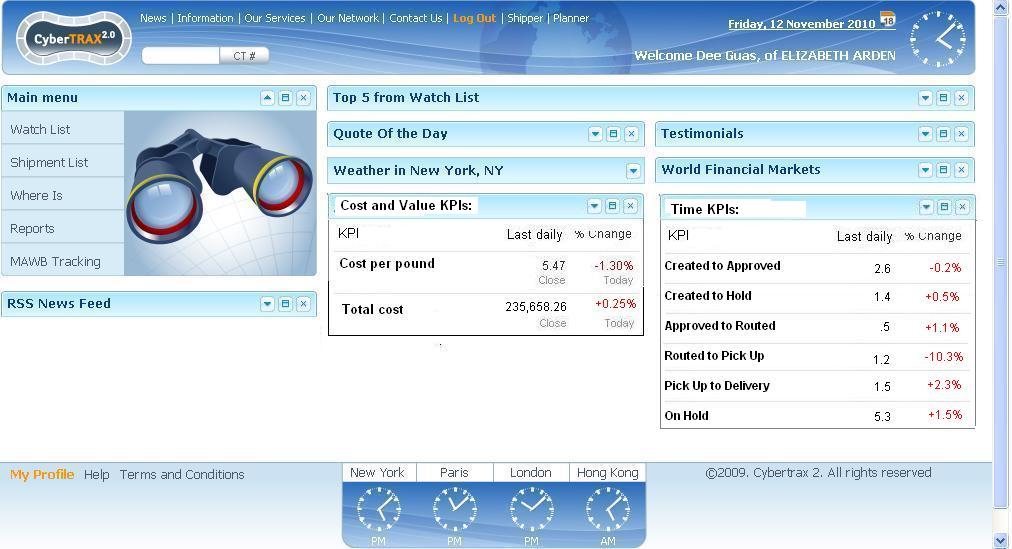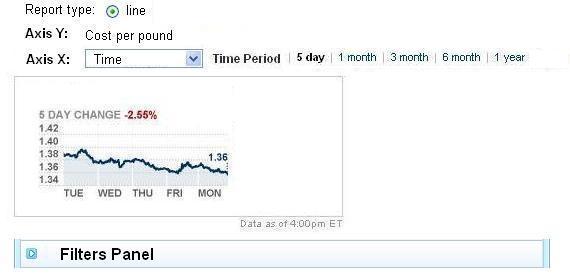AN ORIGINAL KPIs for OpsTruck (concepts and requirements)
From UG
(→Design Requirements) |
(→Design Requirements) |
||
| Line 62: | Line 62: | ||
* show delivery locations with Cost Per Pound and Total Cost KPIs info for each individual location | * show delivery locations with Cost Per Pound and Total Cost KPIs info for each individual location | ||
* show pick up/delivery clusters with number of locations/loads in a cluster | * show pick up/delivery clusters with number of locations/loads in a cluster | ||
| - | * map should have a set of standard | + | * map should have a set of standard ''Filters'' |
* zoom in/out feature | * zoom in/out feature | ||
* ability to set an "abstract" look and feel (only major cities / state borders should be on the map, no other details) | * ability to set an "abstract" look and feel (only major cities / state borders should be on the map, no other details) | ||
Revision as of 19:08, 23 November 2010
Contents |
Parent Mantis
2488: [Arden KPI]......... <proj>
Requirements
Glossary
- KPI (Key Performance Indicator) - see http://en.wikipedia.org/wiki/KPI
- Arden Trucking Project - this is an evolving project of supporting Transportation and Supply Chain needs for Arden. Some components that have been added to CT2 for this project:
Core need
It is to provide reporting for a number of KPIs for Arden management for Arden Trucking Project and Supply Chain Geography reporting.
Phase 1 Scope
KPIs for Phase 1:
- Cost:
- Cost per pound
- Total cost
- Time:
- Created to Approved
- Created to Hold
- Approved to Routed
- Routed to Pick Up
- Pick up to Delivery
- On hold
Supply Chain Geography (phase 1 version).
Design Requirements
Multiple levels. Reporting for each KPI should have several levels. User should be presented with a KPI on a dashboard level (minimal info) and be able to drill down to more finite details (down to the load / CT details).
Standardization. For every KPI approach to UI design should be similar in principle and as standard as possible.
Report types. For every KPI provide the following report types:
- dashboard version
- KPI as a function of time
- KPI as a function of various variables such as CT fields (examples: Carrier, Shipper, Origin State, etc)
- line / bar / pie layouts
Filters. Provide set of standard filters. Ideally every CT field should be represented by a filter. Use multiselect filters where appropriate.
Fields on CT/Load version. On this type of report ideally:
- list columns should cover all CT fields
- user should be able to manage order of columns and what columns are included and what are excluded
Personalization. Some settings should be configured in a user or / and Client profile. Example: some users might want to see year-to-date cost on a dashboard and some month-to-date cost.
Supply Chain Geography. This should be a Google type interactive map with the following capabilities:
- show pick up locations with Cost Per Pound and Total Cost KPIs info for each individual location
- show delivery locations with Cost Per Pound and Total Cost KPIs info for each individual location
- show pick up/delivery clusters with number of locations/loads in a cluster
- map should have a set of standard Filters
- zoom in/out feature
- ability to set an "abstract" look and feel (only major cities / state borders should be on the map, no other details)
Design Ideas
Please note that information in this section represents just ideas. At the programming stage this design could be used or/and (partially) replaced with a better design.
Level 1: Dashboard
If user clicks on any number on dashboard system will take it to the Level 2
Level 2: Axis X is time
If user clicks on any specific area of the plot then system will take user to the Level 3 and display information related to that area.
Level 2: Axis X is Selected Carriers and Report type is Bar Chart
If user clicks on any specific area of the plot then system will take user to the Level 3 and display information related to that area. For example if user clicks on UPS bar then on Level 3 we will see only UPS loads.
Level 2: Cost per pound Axis X is Selected Shippers and Report type is Map
Level 3: Load and CT level
SA Notes
Formulas and mapping for Cost KPIs
Total cost:
Total cost for day X = Cost of all loads delivered on day X
Cost per pound:
Cost per pound for load = (cost of load) / (weight of load in pounds)
Cost Per Pound for day X = Cost of all loads delivered on day X / total weight of these loads
Average Estimated Cost Per Pound of YRC in November = Cost of all loads handled in November by YRC / total weight of these loads
Formulas and mapping for Time KPIs
All numbers below should have 2 decimals.
KPIs below are measures in time elapsed (in days) between 2 dates in the system.
For dates that may be set and re-set use earliest or lates date - whichever is available in the system. Example: for Created to Hold - measure from created to first/last time on hold.
- Created to Approved
- Created to Hold
- Approved to Routed
- Routed to Pick Up
- Pick up to Delivery
On hold - time elapsed (in days) during which CT has "On hold" status.
Mapping:
- Created - CT#Created On Date
- Approved - CT#Approved On
- Hold
- Routed - timestamp when CT#Pick Up Trucker or CT#Delivery Trucker is set
- Pick Up - CT#Actual Export Pick Up Date
- Delivery - CT#Actual Delivery Date
History
Original ver
Rewrite based on feedback from Simon and Marc
Links to old designs:
See Average times
See Maps






